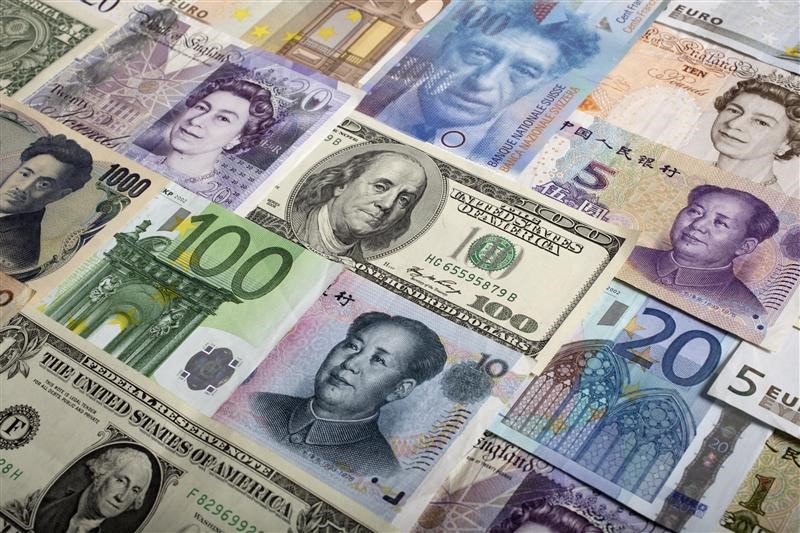* ECB emergency action stems rout in EZ bonds
* UST yields elevated even after Fed unveils MMF facility
* Australian yields soar despite RBA measures
* BOJ conducts 2 unscheduled bond buying as yields rise
* Britain's yields falls after BoE rate cut (Updates with price action in UK, Germany, adds quote)
By Hideyuki Sano and Dhara Ranasinghe
TOKYO/LONDON, March 19 (Reuters) - Major central bank action helped staunch heavy losses on global bond markets on Thursday, with euro zone and U.S. borrowing costs easing modestly, even though the rising risk of recession and hefty fiscal stimulus means the rally is a fragile one.
In another day of incredibly volatile trade, Australian bond yields jumped to their highest in almost a year while Swiss 10-year yields rose to their highest since May last year.
But in the euro zone's southern bond markets, borrowing costs were down sharply after the European Central Bank's emergency action that increases its 2020 stimulus plan to a trillion euros.
And British gilt yields, which had risen sharply earlier in the day, tumbled after the Bank of England cut interest rates to 0.1% and ramped up its bond-buying program. (BoE) move does help but whether this or other central bank action will help draw a line under risky assets, I'm not convinced," said Adam Cole, chief currency strategist at RBC Capital Markets.
Two-year British gilt yields were last down 13 basis points on the day at around 0.21% GB2YT=RR , reversing earlier rises.
In Italy, at the centre of both the coronavirus outbreak in Europe and the selling in bond markets, 10-year borrowing costs slid over 70 basis points to 1.52% IT10YT=RR . They were last down 45 bps on the day, set for the biggest one-day fall since 2011.
"The bond market reaction to the ECB's announcement has been very encouraging against the backdrop of huge uncertainty," said Pictet Wealth Management strategist Frederik Ducrozet.
"It's not the end of the story, there will be hiccups as the ball is now firmly in the fiscal court. But, the safety net is now in place."
WILD SWINGS
But trade remained volatile in a week where desperate investors have dumped government bonds and hoarded cash in markets gripped by pandemic fears.
German 10-year bond yields were 5 bps higher at -0.18% DE10YT-RR on fresh signs that Germany was about to ramp up spending in the face of coronavirus.
With economies around the world disrupted by widespread travel restrictions and economic activity near a standstill, foreshadowing a deep recession at least on a par with the 2008 global financial crisis, bonds have not been spared.
The recent sell-off in equities and currency markets has prompted investors to abandon government bonds, normally considered a safe asset, to make up for losses elsewhere and to stock up on cash, particularly dollars.
"Everybody is hoarding dollars, much like people are stocking up toilet rolls around the world now," said Masayuki Murata, general manager of balanced portfolio investment at Sumitomo Life Insurance in Tokyo.
"You never know whether you really need that many toilet rolls. Some people may have piles of them. But they won't let them go now... The routs are driven not so much by heavy selling as lack of bidders."
Brokerages, with their trading books damaged, are restricting trading. As orders in markets have fallen to a trickle, market fluctuations have widened to unprecedented levels for many traders.
Australia's 10-year bond yield jumped more than 50 basis points to 1.647% AU10YT=RR , reaching its highest level since last May, even after the Reserve Bank of Australia cut interest rates for a second time this month and launched quantitative easing in an emergency move. quite a dislocated market. We are one of the market makers. The reason we are pricing defensively is because you don't want to be caught with a lot of inventory on the book," said Su-Lin Ong, managing director at RBC Capital Markets in Sydney.
Analysts said the large moves in long-dated bond yields globally have been "largely disconnected" from fundamentals or central bank decisions, with technical factors playing a much bigger role in amplifying these moves.
Even in the U.S. bond market, the most liquid in the world, trading has become highly erratic.
The U.S. 10-year Treasury yield US10YT=RR , while lower on Thursday, is almost 1 percentage point above its record low of 0.318% touched last week, despite the U.S. Federal Reserve's one percentage point rate cut on Sunday.
The market hardly budged after the U.S. Fed rolled out yet another emergency credit programme, announcing it would make loans to banks that offer as collateral assets purchased from money market mutual funds (MMFs). Bank of Japan meanwhile conducted two unscheduled government bond purchases totalling 1.3 trillion yen ($11.95 billion) to help quell the market.
Still, that did not stop the market's price slide. The 10-year JGB yield JP10YTN=JBTC climbed 4 basis points to 0.090%, a high last seen in late 2018, while the five-year yield gained 2.5 basis points to minus 0.050% JP5YTN=JBTC .
<^^^^^^^^^^^^^^^^^^^^^^^^^^^^^^^^^^^^^^^^^^^^^^^^^^^^^^^^^^^ A volatile week for bonds
https://tmsnrt.rs/2PMkPA5 10-year bond yields
https://tmsnrt.rs/2wb3c6g
^^^^^^^^^^^^^^^^^^^^^^^^^^^^^^^^^^^^^^^^^^^^^^^^^^^^^^^^^^^>
